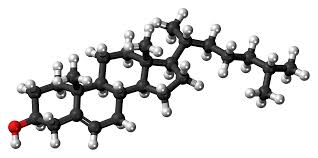
What is Cholesterol? A Thread.
Cholesterol is an organic molecule belonging to the Lipid Family and serves two main functions:
-It contributes to a healthy cell membrane
-It’s an essential component in hormonal development, primarily cortisol, estrogen & testosterone 1/
Cholesterol is an organic molecule belonging to the Lipid Family and serves two main functions:
-It contributes to a healthy cell membrane
-It’s an essential component in hormonal development, primarily cortisol, estrogen & testosterone 1/

All cells in r body can synthesize cholesterol but it’s only the liver than can break it down in any amount and excrete it. Whenever we eat, we take in cholesterol and triglycerides (which are nothing but fatty acids) which get re-synthesised in the intestines into particles 2/ 

To transport these particles to other parts of the body like skeletal muscles, adipose tissue and heart, these particles need to be a certain structure which is provided by a protein known by the short form APoB-48 (Apo-lipoprotein B-48) 3/
These particles then deposit the fatty acids out of triglycerides into skeletal muscles, adipose tissues and the heart. Post the deposition of the fatty acids, the particles become smaller in size. They then go to the Liver and drop off the cholesterol. 4/
As liver gets inundated with fatty acids and cholesterol from all over the body, they regulate this by a system called the VLDL APOB System (VLDL stands for very low-density lipoprotein). These VLDL particles have the molecule of APOB-100 which is bigger in size than APOB48 5/
and these VLDL particles REMOVES triglycerides and cholesterol FROM liver to maintain the balance. VLDL then deposits d triglycerides 2 the adipose tissue & skeletal muscles post which it gets smaller in size with a relative higher concentration of cholesterol 6/
since triglycerides have been partially dropped off at the locations shared above. VLDL then converts to LDL. When we measure the cholesterol in the blood, the total cholesterol consists of Triglycerides, VLDL, LDL and HDL (which is called the good cholesterol) 7/
However along with the Lipid Profile however there is a lot of merit in measuring the APOB because of the following reasons:
-A person may have a reasonably low count of bad cholesterol but can have a high APOB count which can imply that the carriers (particles) that carry 8/
-A person may have a reasonably low count of bad cholesterol but can have a high APOB count which can imply that the carriers (particles) that carry 8/
cholesterol and triglycerides are relatively high.
-Two people having the same Non-LDL Cholesterol Count but one of them having a higher APOB particle count is at a greater atherogenic risk than the one with the lower APOB particle count 9/
-Two people having the same Non-LDL Cholesterol Count but one of them having a higher APOB particle count is at a greater atherogenic risk than the one with the lower APOB particle count 9/
Why is the Lipid Profile important? Because cholesterol (more specifically sterol) in the artery walls is the single most important cause of tissue damage in the heart which leads to a CAD or a Heart Attack.
Why is a heart attack so important to consider? 10/
Why is a heart attack so important to consider? 10/
Let us have a look at the question below and try and guess the reasons.
What’s the most common thing that will present itself in case of 1st heart attack?
Is it Chest Pain?.. No
Is it Nausea?.. No
Is it Left Arm Pain? .. No 11/
What’s the most common thing that will present itself in case of 1st heart attack?
Is it Chest Pain?.. No
Is it Nausea?.. No
Is it Left Arm Pain? .. No 11/
The correct answer is sudden death.
In the US a little less than 50% of 1st heart attacks are fatal and Atherosclerosis is the most certain terminal disease that afflicts all humans. It's not cancer it's atherosclerosis. 12/
In the US a little less than 50% of 1st heart attacks are fatal and Atherosclerosis is the most certain terminal disease that afflicts all humans. It's not cancer it's atherosclerosis. 12/
The intention is to make people aware of the importance of cholesterol, make it simple for our minds to grasp its relevance and mitigate risk factors in our lives from the mid 30's onwards.
#health #Harmony #happiness 13/13
--all pictures are sourced from the internet--
#health #Harmony #happiness 13/13
--all pictures are sourced from the internet--
• • •
Missing some Tweet in this thread? You can try to
force a refresh







